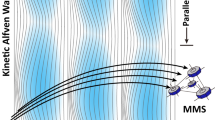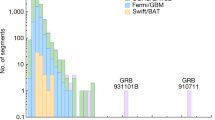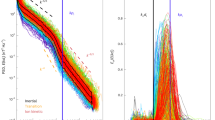Abstract
The Sun frequently accelerates near-relativistic electron beams that travel out through the solar corona and interplanetary space. Interacting with their plasma environment, these beams produce type III radio bursts—the brightest astrophysical radio sources seen from Earth. The formation and motion of type III fine frequency structures is a puzzle, but is commonly believed to be related to plasma turbulence in the solar corona and solar wind. Combining a theoretical framework with kinetic simulations and high-resolution radio type III observations using the Low-Frequency Array, we quantitatively show that the fine structures are caused by the moving intense clumps of Langmuir waves in a turbulent medium. Our results show how type III fine structure can be used to remotely analyse the intensity and spectrum of compressive density fluctuations, and can infer ambient temperatures in astrophysical plasma, substantially expanding the current diagnostic potential of solar radio emission.
This is a preview of subscription content, access via your institution
Access options
Access Nature and 54 other Nature Portfolio journals
Get Nature+, our best-value online-access subscription
$29.99 / 30 days
cancel any time
Subscribe to this journal
Receive 12 digital issues and online access to articles
$119.00 per year
only $9.92 per issue
Buy this article
- Purchase on Springer Link
- Instant access to full article PDF
Prices may be subject to local taxes which are calculated during checkout






Similar content being viewed by others
Data availability
The simulation datasets generated during and/or analysed during the current study are available from the corresponding author on reasonable request. LOFAR data used during the current study are publicly available on the LOFAR Long Term Archive at https://lta.lofar.eu/ under the project codes LC3_012 and LC4_016. The data used to make the plots in the paper are available on the UCL Research Data Repository using https://doi.org/10.5522/04/14140007.
Code availability
The code used to make the plots in the paper is available on the UCL Research Data Repository using https://doi.org/10.5522/04/14140679. The code used to generate the datasets in our study is currently in preparation to be made publicly available. In the interim period, the code can be made available from the corresponding author on reasonable request.
References
Suzuki, S. & Dulk, G. A. Bursts of Type III and Type V 289–332 (Cambridge Univ. Press, 1985).
Pick, M. & Vilmer, N. Sixty-five years of solar radioastronomy: flares, coronal mass ejections and Sun Earth connection. Astron. Astrophys. Rev. 16, 1–153 (2008).
Reid, H. A. S., Vilmer, N. & Kontar, E. P. The low-high-low trend of type III radio burst starting frequencies and solar flare hard X-rays. Astron. Astrophys. 567, A85 (2014).
Aschwanden M. J. Physics of the Solar Corona. An Introduction with Problems and Solutions 2nd edn (Praxis, 2005).
Holman, G. D. et al. Implications of X-ray observations for electron acceleration and propagation in solar flares. Space Sci. Rev. 159, 107–166 (2011).
Dulk, G. A. Radio emission from the sun and stars. Annu. Rev. Astron. Astrophys. 23, 169–224 (1985).
Posner, A. Up to 1-hour forecasting of radiation hazards from solar energetic ion events with relativistic electrons. Space Weather 5, 05001 (2007).
de La Noe, J. & Boischot, A. The type III B burst. Astron. Astrophys. 20, 55 (1972).
Abranin, E. P. et al. Angular sizes of stria-burst sources in the range 24–26 MHz. Sol. Phys. 57, 229–235 (1978).
Kontar, E. P. et al. Imaging spectroscopy of solar radio burst fine structures. Nat. Commun. 8, 1515 (2017).
Melnik, V. N., Brazhenko, A. I., Frantsuzenko, A. V., Dorovskyy, V. V. & Rucker, H. O. Properties of decameter IIIb–III pairs. Sol. Phys. 293, 26 (2018).
Melrose, D. B. Frequency splitting in stria bursts—possible roles of low-frequency waves. Sol. Phys. 87, 359–371 (1983).
Kolotkov, D. Y., Nakariakov, V. M. & Kontar, E. P. Origin of the modulation of the radio emission from the solar corona by a fast magnetoacoustic wave. Astrophys. J. 861, 3 (2018).
Sharykin, I. N., Kontar, E. P. & Kuznetsov, A. A. LOFAR observations of fine spectral structure dynamics in type IIIb radio bursts. Sol. Phys. 293, 115 (2018).
Pécseli, H. Waves and Oscillations in Plasmas (Taylor & Francis, 2012).
Chen, X. et al. Fine structures of solar radio type III bursts and their possible relationship with coronal density turbulence. Astrophys. J. 856, 73 (2018).
van Haarlem, M. P. et al. LOFAR: the Low-Frequency Array. Astron. Astrophys. 556, A2 (2013).
Lemen, J. R. et al. The Atmospheric Imaging Assembly (AIA) on the Solar Dynamics Observatory (SDO). Sol. Phys. 275, 17–40 (2012).
Reid, H. A. S. & Kontar, E. P. Solar wind density turbulence and solar flare electron transport from the Sun to the Earth. Astrophys. J. 721, 864–874 (2010).
Li, B., Cairns, I. H. & Robinson, P. A. Frequency fine structures of Type III bursts due to localized medium-scale density structures along paths of type III beams. Sol. Phys. 279, 173–196 (2012).
Loi, S. T., Cairns, I. H. & Li, B. Production of fine structures in type III solar radio bursts due to turbulent density profiles. Astrophys. J. 790, 67 (2014).
Reid, H. A. S. & Kontar, E. P. Langmuir wave electric fields induced by electron beams in the heliosphere. Astron. Astrophys. 598, A44 (2017).
Melrose, D. B., Cairns, I. H. & Dulk, G. A. Clumpy Langmuir waves in type III solar radio bursts. Astron. Astrophys. 163, 229–238 (1986).
Parker, E. N. Dynamics of the interplanetary gas and magnetic fields. Astrophys. J. 128, 664 (1958).
Reid, H. A. S. & Kontar, E. P. Spatial expansion and speeds of type III electron beam sources in the solar corona. Astrophys. J. 867, 158 (2018).
Li, B. & Cairns, I. H. Fundamental emission of type III bursts produced in non-Maxwellian coronal plasmas with kappa-distributed background particles. Sol. Phys. 289, 951–976 (2014).
Li, B. & Cairns, I. H. Type III bursts produced by power law injected electrons in Maxwellian background coronal plasmas. J. Geophys. Res. Space Phys. 118, 4748–4759 (2013).
Newkirk, G. The solar corona in active regions and the thermal origin of the slowly varying component of solar radio radiation. Astrophys. J. 133, 983 (1961).
Mugundhan, V., Hariharan, K. & Ramesh, R. Solar type IIIb radio bursts as tracers for electron density fluctuations in the corona. Sol. Phys. 292, 155 (2017).
Zhang, P., Yu, S., Kontar, E. P. & Wang, C. On the source position and duration of a solar type III radio burst observed by LOFAR. Astrophys. J. 885, 140 (2019).
Kontar, E. P. et al. Anisotropic radio-wave scattering and the interpretation of solar radio emission observations. Astrophys. J. 884, 122 (2019).
Chen, C. H. K. et al. Three-dimensional structure of solar wind turbulence. Astrophys. J. 758, 120 (2012).
Krupar, V. et al. Density fluctuations in the solar wind based on type III radio bursts observed by Parker Solar Probe. Astrophys. J. Suppl. Ser. 246, 57 (2020).
Stappers, B. W. et al. Observing pulsars and fast transients with LOFAR. Astron. Astrophys. 530, A80 (2011).
Kontar, E. P. Dynamics of electron beams in the inhomogeneous solar corona plasma. Sol. Phys. 202, 131–149 (2001).
Ryutov, D. D. Quasilinear relaxation of an electron beam in an inhomogeneous plasma. Sov. J. Exp. Theor. Phys. 30, 131 (1969).
Vedenov, A. A. Quasi-linear plasma theory (theory of a weakly turbulent plasma). J. Nucl. Energy 5, 169–186 (1963).
Drummond, W. E. & Pines, D. Nonlinear plasma oscillations. Ann. Phys. 28, 478–499 (1964).
Zheleznyakov, V. V. & Zaitsev, V. V. Contribution to the theory of type III solar radio bursts. I. Sov. Astron. 14, 47 (1970).
Melrose D. B. Plasma Astrophysics: Nonthermal Processes in Diffuse Magnetized Plasmas. Vol. 2: Astrophysical Applications (Gordon and Breach Science Publishers, 1980).
Tsytovich V. N. Lectures on Non-linear Plasma Kinetics (Springer Verlag, 1995).
Lyubchyk, O., Kontar, E. P., Voitenko, Y. M., Bian, N. H. & Melrose, D. B. Solar plasma radio emission in the presence of imbalanced turbulence of kinetic-scale Alfvén waves. Sol. Phys. 292, 117 (2017).
Maksimovic, M. et al. Radial evolution of the electron distribution functions in the fast solar wind between 0.3 and 1.5 au. J. Geophys. Res. Space Phys. 110, A09104 (2005).
Mann, G., Jansen, F., MacDowall, R. J., Kaiser, M. L. & Stone, R. G. A heliospheric density model and type III radio bursts. Astron. Astrophys. 348, 614–620 (1999).
Celnikier, L. M., Harvey, C. C., Jegou, R., Moricet, P. & Kemp, M. A determination of the electron density fluctuation spectrum in the solar wind, using the ISEE propagation experiment. Astron. Astrophys. 126, 293–298 (1983).
Celnikier, L. M., Muschietti, L. & Goldman, M. V. Aspects of interplanetary plasma turbulence. Astron. Astrophys. 181, 138–154 (1987).
Chen, C. H. K. et al. Kinetic scale density fluctuations in the solar wind. AIP Conf. Proc. 1539, 143 (2013).
Reid, H. A. S., Vilmer, N. & Kontar, E. P. Characteristics of the flare acceleration region derived from simultaneous hard X-ray and radio observations. Astron. Astrophys. 529, A66 (2011).
Woo, R., Armstrong, J. W., Bird, M. K. & Patzold, M. Variation of fractional electron density fluctuations inside 40 R0 observed by ULYSSES ranging measurements. Geophys. Res. Lett. 22, 329–332 (1995).
Sasikumar Raja, K., Subramanian, P., Ramesh, P., Vourlidas, A. & Ingale, M. Turbulent density fluctuations and proton heating rate in the solar wind from 9–20 solar radii. Astrophys. J. 850, 129 (2017).
Krupar, V. et al. Interplanetary type III bursts and electron density fluctuations in the solar wind. Astrophys. J. 857, 82 (2018).
Bisoi, S. K. et al. A study of density modulation index in the inner heliospheric solar wind during solar cycle 23. Astrophys. J. 795, 69 (2014).
Acknowledgements
We acknowledge support by the Science and Technology Facilities Council (STFC) Consolidated Grant ST/L000533/1. This work benefited from the Royal Society grant RG130642. This paper is based (in part) on data obtained with the International LOFAR Telescope (ILT) under project codes LC3_012 and LC4_016. LOFAR17 is the Low-Frequency Array designed and constructed by ASTRON. It has observing, data processing and data storage facilities in several countries that are owned by various parties (each with their own funding sources), and that are collectively operated by the ILT foundation under a joint scientific policy. The ILT resources have benefitted from the following recent major funding sources: CNRS-INSU, Observatoire de Paris and Université d’Orléans, France; BMBF, MIWF-NRW, MPG, Germany; Science Foundation Ireland (SFI), Department of Business, Enterprise and Innovation (DBEI), Ireland; NWO, The Netherlands; The Science and Technology Facilities Council, UK
Author information
Authors and Affiliations
Contributions
Both H.A.S.R. and E.P.K. contributed towards the theoretical, numerical and data analysis required for this study, and for the writing of the text. Figures were created by H.A.S.R.
Corresponding author
Ethics declarations
Competing interests
The authors declare no competing interests.
Additional information
Peer review information Nature Astronomy thanks Peter Yoon and the other, anonymous, reviewer(s) for their contribution to the peer review of this work.
Publisher’s note Springer Nature remains neutral with regard to jurisdictional claims in published maps and institutional affiliations.
Extended data
Extended Data Fig. 1 Illustration of the observed type III radio intensity fluctuations.
The peak flux for the fundamental emission of the three type III bursts observed by LOFAR, shown in Fig. 1, on a, 16th April, b, 24th June and c, 16th September. Errors calculated from the square root of the radio flux are indicated in red. The smoothed functions, used to calculate the values of ΔI/I are shown in green.
Extended Data Fig. 2 Illustration of the simulated type III radio intensity fluctuations.
a, Peak brightness temperature as a function of frequency for the simulated type III dynamic spectra propagating through plasma where Δn/n = 2.5 × 10−3. The smoothed function used to calculate ΔI/I is overplotted in green. b, same as panel a but Δn/n = 2.5 × 10−4.
Extended Data Fig. 3 Simulated beam-drive Langmuir wave energy density and associated power density spectra.
a, Beam-generated Langmuir wave energy density ULW as a function of distance. The background plasma has a sinusoidal perturbation with amplitude A = 0.001 and wavelength λ = 50 Mm in blue and λ = 10 Mm in red. The lower panel highlights the modulation in the background plasma gradient length scale \(L=0.5{n}_{e}^{-1}d{n}_{e}/dx\). b, Power density spectrum of the Langmuir wave energy density minus the unperturbed case from the simulations shown in panel a. The peaks occur at the wavenumber k1 = 2π/λ Mm−1 and the harmonics. The simulation with a lower wavelength density fluctuations clearly modulates the Langmuir waves at higher wavenumbers.
Rights and permissions
About this article
Cite this article
Reid, H.A.S., Kontar, E.P. Fine structure of type III solar radio bursts from Langmuir wave motion in turbulent plasma. Nat Astron 5, 796–804 (2021). https://doi.org/10.1038/s41550-021-01370-8
Received:
Accepted:
Published:
Issue Date:
DOI: https://doi.org/10.1038/s41550-021-01370-8
This article is cited by
-
Defining the Middle Corona
Solar Physics (2023)



